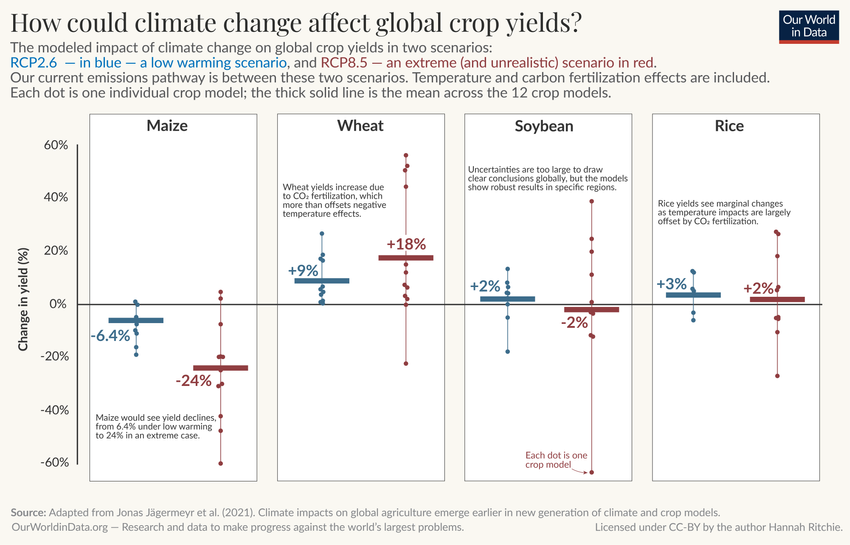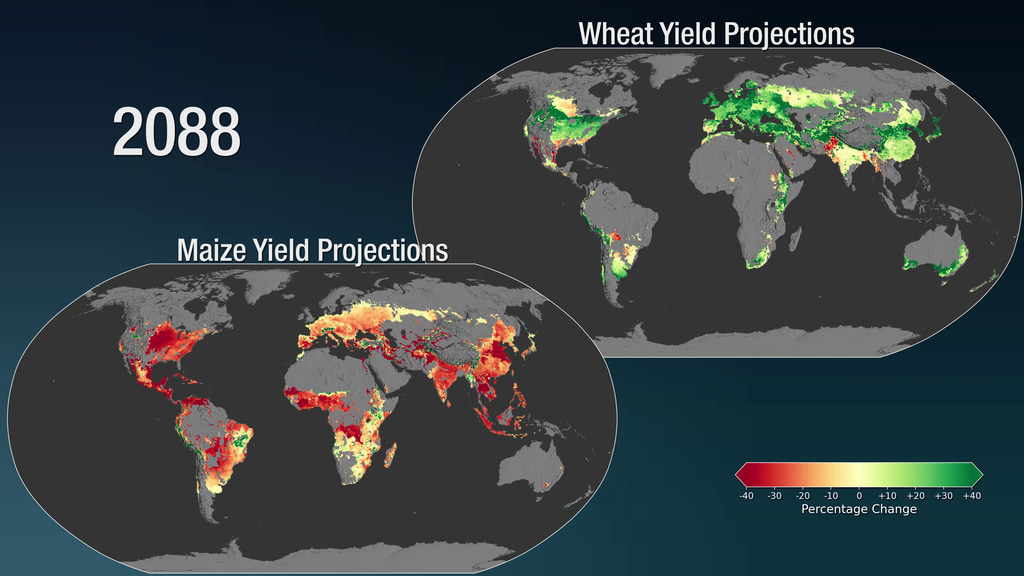Hey! Ever wondered what it'll be like to grow food on an increasingly hot planet?
How will we feed 8, 9, or even 10 billion people in a world transformed by climate change?
It's a fascinating puzzle that scientists worldwide are trying to solve - and today we're diving deep into this mystery!
🌱 The Three Main Characters in Our Story
1. CO₂: Our Frenemy
Think of CO₂ as that friend who treats everyone differently:
- For "C3" plants (like wheat and rice): It's like a super fertilizer! They love it and grow much better For "C4" plants (corn, millet, and sorghum): Barely makes a difference, except during droughts
This phenomenon is known as "carbon fertilization" - but don't be fooled, it's not a magical solution!
2. Temperature: The Goldilocks Dance
It's just like the Goldilocks story - everything needs to be just right:
- Temperate regions: A little extra warmth might actually help
- Tropical regions: Already at the "too hot" threshold, and any increase is problematic
- Plants have their "ideal temperature," and when we exceed that... well, they're not happy at all!
3. Water: The Delicate Balance
- Too much water? Everything gets waterlogged and rots
- Too little water? Everything withers and dies
- You need that perfect balance! (Which is becoming increasingly harder to find)
📊 Navigating the Numbers: What Does the Future Hold?
 |
For Corn (The Drama):
- Optimistic Scenario (warming below 2°C): 6% drop in global production
- Pessimistic Scenario (3-5°C warmer): A staggering 24% loss!
- Even Europe, typically cooler, might see drops of up to 20%
For Wheat (The Positive Surprise):
- Could increase up to 18% in the most extreme scenario!
- With 2°C warming:
- Without CO₂ effect: -6.6%
- With CO₂ effect: +1.7%
- European winter wheat might get a 4% boost by 2050
Rice and Soybeans (The Moderates):
Milder impacts:
- Extra heat hurts, but extra CO₂ compensates
- Asian countries might see 0% to 10% increases in rice production
🗺️ A World Tour of Impacts
In Northern Lands (Temperate Countries):
- Might be the unintentional "winners"
- Higher temperatures could extend growing seasons
- Still need to deal with extreme weather events
In the Tropics (The Critical Zone):
- Already near the limit of what plants can handle
- Heavily dependent on crops that don't benefit from extra CO₂
- Lower technological adaptation capacity
The Hidden Risks
Extreme Events:
- Floods and droughts may become more frequent
- Waterlogging losses could jump from 3% to 20% by 2080
- Food markets might become more unstable
Climate Injustice:
- Countries that contributed least to climate change will suffer most
- Sub-Saharan Africa and South America: Highly dependent on corn
- Poor countries: Rely on millet and sorghum, precisely the most threatened crops
Real-Life Impacts
In South America and Africa:
- Corn is a staple food
- Hunger rates are already high
- Most of the population works in agriculture
- Yields are already low
Social Consequences:
- Threat to food security
- Risk of deepening poverty
- Possible increase in food prices
- Greater social instability
The Global Outlook
It's like a climate chess game where:
- Rich countries that emitted most CO₂ might see their wheat harvests increase
- Poor countries that contributed least will face the biggest losses
- Food production might become more unpredictable
- We'll need new adaptation strategies
🌱 The Future is Not Written: Why There's Hope for Our Agriculture
A Surprising Truth
When we say that climate change might reduce agricultural production by 5%, what does that really mean? It's not quite what you might think!
History Teaches Us:
- Since 1961, even with climate change reducing harvests by 5%...
- Global production has increased by more than 200%!
- It's like a runner who keeps breaking records, even against the wind
The Power of Untapped Potential
The "Yield Gap" Concept
Imagine a ladder where:
- The current step is where we are
- The top step is where we could be
- The distance between them? That's the "yield gap"!
A Real Example: The Kenya Case
- Current production: 1.4 tons per hectare
- Possible potential: 4.2 tons per hectare
- Yield gap: 2.8 tons of possibilities!
Doing the Math:
- Worst climate scenario: -25% = loss of 0.3 tons
- Potential improvement: +2.8 tons
- The potential for improvement is 9 times greater than the possible loss!
🥗 What About Other Foods?
Beyond major grains, we have a whole world of:
- Fruits
- Vegetables
- Legumes
- Seeds
What Science Says:
- With more CO₂ (250 ppm increase):
- 22% average increase in production
- Legumes: greatest benefits
- Leafy vegetables: moderate benefits
- With temperature 4°C higher:
- Cold regions (below 20°C): +35%
- Hot regions (above 20°C): -32%
- Global average: -5%
The Adaptation Game
What We Can Do:
- Invest in Technology 🔬
- Better seeds
- More efficient agricultural practices
- Smart irrigation systems
- Reduce Disparities 🤝
- Share knowledge
- Improve resource access
- Support vulnerable farmers
- Innovate for Resilience 💪
- Develop heat-resistant crops
- Create drought-tolerant varieties
- Adapt farming practices locally
The Final Message
The future of agriculture doesn't depend solely on climate change. It's like a 3D chess game where we need to:
- Combat climate change ♟️
- Improve current agricultural practices ♟️
- Develop new technologies ♟️
The Good News:
We have the tools and knowledge to increase production, even in a changing climate. The challenge isn't whether we can do it, but ensuring these solutions reach all farmers, everywhere.
In the next article, we'll dive into specific adaptation strategies that can transform these challenges into opportunities!
Credits and related papers:
NASA's Scientific Visualization Studio
Hannah Ritchie (2024) - “How will climate change affect crop yields in the future?” Published online at OurWorldinData.org. Retrieved from: 'https://ourworldindata.org/will-climate-change-affect-crop-yields-future' [Online Resource]

